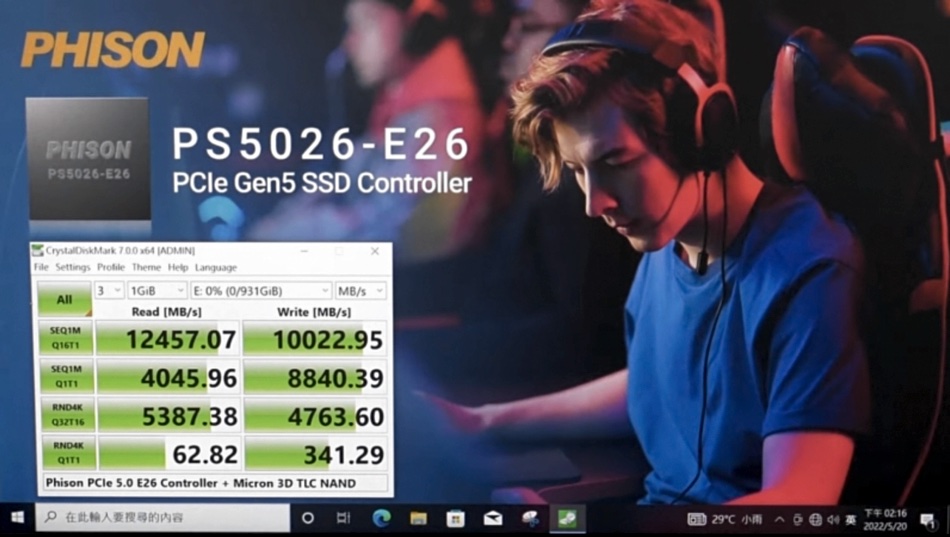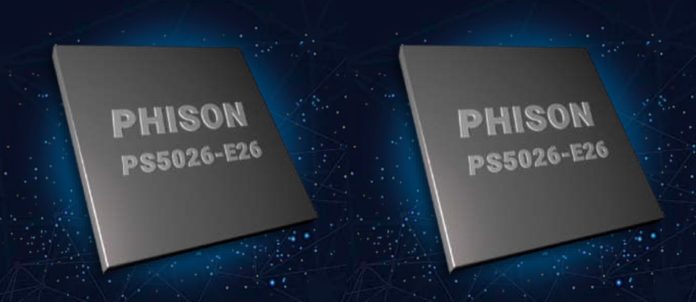Phison has tested its PCIe 5 controller in a proof-of-concept SSD with impressive IOPS and bandwidth numbers presaging what we can expect from enterprise SSDs using the fifth PCIe generation bus.
Update: Kioxia views re E26 performance added 27 June 2022.
PCIe 5 operates at 4GB/sec per lane, twice PCIe 4’s 2GB/sec per lane, and four times as fast as PCIe 3’s 1GB/sec per lane. PCIe 3 is used by the vast majority of installed and shipping NVMe-access SSDs. Phison has been building up to producing a PCIe 5 controller and has now tried out its PS5026-E26 device using an M.2 2580 format gumstick card populated with 1TB of Micron 3D NAND in TLC format.
SK hynix’s Platinum P41 M.2 SSD delivers sequential read speeds up to 7,000 MB/s and sequential write speeds up to 6,500 MB/s, and up to 1,400K random read IOPS and up to 1,300K random write IOPS on PCIe 4.
The PS5026-E26 delivered 12,457 MB/sec sequential read and 10,047 MB/sec sequential write bandwidth using a CrystalDiskMark test, almost doubling the Platinum’s P41 bandwidth numbers.

Phison claims it will deliver up to 13,500 MB/sec sequential read bandwidth and 12,000 MB/sec sequential write bandwidth. We placed these numbers in a table along with other PCIe 5 SSD numbers to get a sense of how Phison’s controller performed:

FADU’s Echo is the random read IOPS king, with its 3.4 million random read IOPS but comparatively poor 735,000 random write IOPS. Its sequential bandwidth is excellent too: 14,600 MB/s reading and 10,400 MB/s when writing.
Samsung’s PM1743 is next best on the random read IOPS front with 2.5 million and a slow 250,000 random write IOPS. Its sequential read bandwidth at 13,000 MB/s isn’t far off FADU, but sequential write is much poorer – just 6,600 MB/sec.
The Phison PS5026-E26 delivered 1.31 million random read IOPS and 1.16 million random write IOPS; a balanced read-write performance profile. But these are lower IOPS numbers than the PCIe 4-using SK hynix Platinum P41 drive; an odd result. Its sequential bandwidth is back to PCIe 5 goodness – 13,500 MB/sec for reads and 12,000 MB/sec for writes – again a balanced picture with no read optimization to speak of.
The two Kioxia CD8 drives are slightly slower than the Phison rig on random read IOPS, at 1.25 million, but slower on random write IOPS at just 200,000. They are quite severely lacking in sequential bandwidth, 7,200 MB/sec reads and 6,000 MB/sec writes – PCIe 4 territory – and look to be outclassed.
Update: A Kioxia source said: “The CD8 really is designed for the Data Center and Enterprise applications and this wasn’t really an apples to apples comparison. The numbers with the E26 Demo were based on a CrystalDiskMark test in a Client environment. While the CD8 specs are based on tests with enterprise usage. Other factors like reliability and use cases like mixed use or read intensive applications really aren’t captured here.”
Phison’s PS5026-E26 controller features 2 x Arm Cortex-R5 cores and 3 x Phison CoXprocessor 2.0 accelerators. It supports TLC and QLC format NAND with capacities up to 32TB, and the ZNS, SR-IOV, ONFI 5.x, Toggle 5.5, and NVMe v2.0 standards.
AMD’s Zen 4 CPU with AM5 motherboards will support PCIe 5 and is expected later this year. Intel’s Alder Lake and Sapphire Rapids CPUs will also support PCIe 5 with appropriate motherboards.
We might hope to see SSD suppliers shipping products using the PS5026-E26 controller possibly in the fourth quarter but likelier in early 2023. Phison says it’s meant for both client and enterprise use so gamers might get a first sight of such SSDs.








